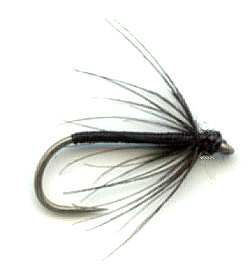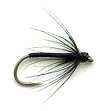The Black Soft Hackle Wet Fly
Black Soft Hackle Spider flies are my first choice for fishing large still waters in the early part of the season when hunting Rainbow and Brown Trout.

SOFT HACKLE NORTH COUNTRY SPIDER WET FLY PATTERNS. Hook size 12 14 - $US each
I call North Country Soft hackle fly patterns 'Spiders'. Not because they imitate spiders but because they look like spiders. This was the name I was told to call them by my Grandfather who taught me how to fly fish. He told me they were developed a long time ago in Yorkshire by a man called Stewart. I have since learnt that a version of this thinly dressed fly has been used for over three hundred years. The Black Spider is the fly I use the most for fishing from the banks of the Bewl during the early part of the season. It is also a fish finder on other large expanses of stillwater. What is it supposed to represent to a hungry trout? Most people say it is an emerging insect swimming to the surface. I think it suggests many things that the trout looks on as food like a caddis, stonefly, midge or a crumpled drowned adult mayfly upwing fly. These flies do not excite certain fly fishermen because they are plain and thin but this is the feature that makes them attractive to Rainbow and Brown Trout.
I like to use light tackle when fishing Black Soft Hackle Spiders. My weapon of choice is a 10 foot 6 or 5wt rod. If you use a heavier outfit it takes some of the subtlety and charm out of fishing this pattern. It is important that you feel every movement through the line. Use a long tapered leader of nine foot tied to a tippet ring to which is tied a further 18 inches to the first dropper. I then add a further 3 foot section to the point fly. I do very the length. I prefer a figure of eight retrieve. They catch fish and it just goes to show that delicate black soft hackle spiders are as effective as large crystal and marabou monster flies in late winter or early spring.
The Black soft hackle spider fly pattern has given me many exciting fishing moments. As soon as the Black Gnats start hatching this fly really comes into its own. I like to fish it at the point and try to keep it dead drift over my target rising trout. The helpless natural insect stuck in or just below the surface film will just drift with the current. This is what you must imitate. I have had success by accurately casting into the rings of a previous trout surface rise. Sometimes it hits them on the nose which is not my intent but in most cases brings one of two results; an immediate take or the flight of the shocked trout. During the rest of the year if I notice any small black insects dropping onto the water I quickly tie on the black spider. Some terrestrial flies who normally live over dry land stray near the water. This can be fatal if they try to land on the water or get blown into it by a gust of wind. Some of these insects just run out of energy over large areas of stillwater. The trout are not picky that these flies should not be on the water. To them they are lunch.
WHO INVENTED THE BLACK SPIDER SOFT HACKLE PATTERN?
The British Georgian Gentleman fly fisher W.C. Stewart designed and promoted the black soft hackle wet fly which he called the Black Spider because of the way the thin hackles looked like spider legs. He lived in and fished the rivers of the Welsh Borders in the mid 1800’s. Some say that he cannot really be called the designer as similar flies had been used for over two hundred years before he started fly fishing. He was the first to write about the fly in an in-depth way.
He described in chapter five of his 1857 book ‘The Practical Angler’ how to tie this fly, what materials to use and more importantly how best to fish the Black Spider soft hackle wet fly. In his younger days fishing was dominated by wet fly fishing downsteam with the current. His book changed that, for he said, quite dogmatically, that the sensible angler should fish upstream. This was revolutionary stuff that rocked a few boats of the fly fishing establishment. He described a series of soft hackle fly patterns to use in different situations including the Black Spider.
He gave four reasons for fishing upstream with a soft hackle wet fly. The first is that the trout and grayling fly fisherman approaches the fish from its blind side, the tail. The second is that the angler strikes into the fish. In downsteam fishing the fly can be pulled straight out of the trout’s mouth. The third advantage is that the fly fisherman disturbs the water far less than when Wading downstream. Lastly Stewart noticed that the fly was presented to the trout in a far more natural way when it was fished upstream without visible drag. As the fly moves downstream the line tightens and the disturbance in the water often scares the fish.
I have fished streams and upper stretches of rivers in the Welsh boarders and have come across the problem of stiff winds flowing downstream with the current. This has made casting upstream with light flies sometimes nearly impossible. I have had to resort to fishing my team of flies that includes W.C. Stewart’s Black Spider soft hackle wet on a middle dropper, downstream. It can be done successfully but you have to watch your line all the time and let out slack so as not to cause the dreaded drag. It is an art that comes with practice you have just the right amount of slack in your line so that when you need to set the hook you can by just lifting the rod.
A team of wet flies cast down and across a fastish current will skate across the surface unless the line is slowed down. A method of doing this is to feed more line through the rings, but this drops the flies downstream. A better way is to make an upstream mend of the line, but the beginner often leaves this until he sees that the flies are skating. They should make the first mend as the line hits the surface and in a fast section of the current this may have to be repeated once or twice as the cast is fished out. If the line can be managed like this so as to produce a gentle curve as the flies cover a rising trout the chance of hooking a taking fish is high.
HIGHLAND LAKE FISHING
On a particularly windy day I was out fishing on a Cumbrian highland lake. One minute the waves were swallowing up my flies and the water would flatten. I had to use a very heavy nymph as a point fly just to get my cast to cut through the wind resistance. I was not alone on this very blustery day. There were two other nutters on the waters edge with me. They were using big leaded Zonker steamers to imitate the small fish silvery fish that could be seen darting around in the shallows. They were catching the odd fair sized brown or rainbow at the rate of around one an hour.
The wind was coming from the north west so I decided to fish the margins around the south east corner of the lake as this is where all the surface floating insect life would be blown towards. I tied on a ribbed black epoxy buzzer on the middle dropper with a black soft hackle three feet above it on the next dropper drifting just under the surface.
I caught some cracking fish. Two were caught on the ribbed black epoxy buzzer but I caught six on the black soft hackle wet, including my top fish of the day, a big 2 1/2lb rainbow trout. What I noticed was that all the takes on the soft hackle fly pattern was when the wind was making the surface choppy. The trout seemed to like swimming just under the waves. There could be a number of reasons for that. The waves oxygenate the water and also drown any surface floating insect life. The waves also make it harder for sea and water birds to spot the fish under the water. They feel safer hunting for food just under the water surface when it is more disturbed.
CUSTOMER'S COMMENT
This pattern is a beautiful delicate pattern that is effective. It recently produced a 17 inch Wild Brown for me. Although intended for when the 'black things' are out and about, I use it from middle of May to the end of August. I usually fish this black gnat soft hackle at middle dropper. I keep my line diameter to a sensible minimum, particularly if the water is low and clear. I feel 2lb is okay but in really problematic situations I will go lower. Peter Feild, Perth
LINKEDIN COMMENT
Do you use soft hackle wet fliers tied to a dropper? - droppers are legal in Montana and a great asset. - by James Savstrom
GOOGLE+ READER'S COMMENT
I use black soft Hackle fly patterns in spring slow retrieve with a slow jerk action stimulating the fish to grab it. - Michael Callen
FACEBOOK READER'S COMMENT
Super simple and a super tricker of trout here in Australia - Barry Ryan


Fly Fishing books

